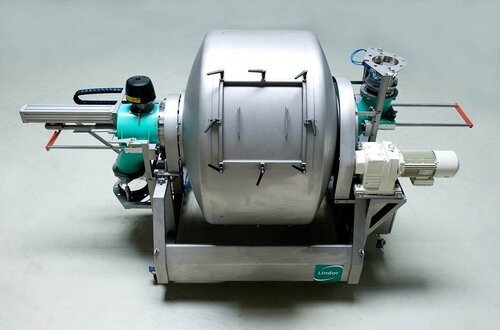Namkeen Mixer Machine
Namkeen mixer machine, also known as farshan mixers or farshan mixing machines, are used to mix various types of sev, nuts, dals, rice flacks, corn flacks, maize flacks, dried fruits, and so on. Namkeen mixer machines can make many types of Namkeen combinations using required components in a sanitary manner.
Namkeen is a Hindi term that describes a delicious taste. Namkeen is sometimes used as a catch-all name for savoury snack items. In Indian food, both black and standard white salt are utilised, giving it the salty flavour that many people enjoy. Khaara, farsan, chivda, sav, chips, and bhujiya are some more namkeen snacks popular in Indian cuisine.
Namkeen meals are primarily intended to be portable, fast, and filling. As a type of convenience food, processed snack foods are meant to be less perishable, more durable, and more portable than cooked foods. They frequently contain high levels of sugars, preservatives, and attractive components like chocolate, peanuts, and specially designed tastes. Apart from being a popular snack, the inclusion of many spices in it promotes digestion.
Gram flour is used to make it. To prepare the dough, spices and other additions are mixed into the gramme flour. The dough for the Namkeen mixer machine is sent through a basic extruder, which produces tiny strands of dough. The strands are cooked in hot cooking oil in a frying pan. After frying, the excess oil is removed and the Namkeen is packed in a Namkeen mixer machine. Boiling and mashing potatoes are added to the flour mixture in a Namkeen mixer machine to make Bhujia.
Namkeen mixer machines are batch mixers that have paddles and blades that are set at a predetermined angle on a spinning stainless steel shaft. This spinning shaft revolves around the axis of a "U" shaped tilt-able drum. Thus fed matirial such as gathiya or gathia such as bhavnagari gathiya, jamnagari gathiya, methi gathiya, makhaniya gathiya, tum tum, sev bhujia such as aloo sev, garlic sev (lasun sev), palak sev (spinach sev), tomato sev, bikaneri bujia, ratlami By gyratory stirring along the vessel wall, the material raised by the paddles gravitates downward in the "U" shaped tiltable jar.
A Namkeen mixer machine was built to replace the traditional method of mixing Namkeen for both residential and commercial purposes. The Namkeen mixer machine's peculiarity stems from the fact that both the mixer basin and the stirrer may be adjusted at whim to fit the nature of the components being mixed. The Namkeen mixer machine was created to improve the sanitary processing of flour into dough for Namkeen and other flour-based items for human consumption. The Namkeen mixer machine replaces the unsanitary and time-consuming traditional method of preparation.
The mixing procedure is at the heart of changing raw components into food for human consumption. One of its primary functions, which is shared by other food processing procedures, is to ensure uniformity. Whether a culinary product necessitates small-scale hand mixing or large-scale blending of many components, both home chefs and process engineers understand the necessity of correct mixing. Even with the appropriate amount of ingredients and tastes, a wonderful recipe will not produce delicious cuisine until the components are well combined. Taste, texture, colour, and appearance are all important factors that are heavily impacted by the mixing procedure.
Features of Namkeen mixer machine
The need for Namkeen mixer machine is increasing since Namkeen mixing is a significant activity in food production in food businesses, Food Industries, bakery Factories, and pizzerias. A Namkeen mixer machine is utilized in the home or the workplace. It is used to knead enormous amounts of namkeen. It is electrical, with timers and other controls to meet the demands of the user.
Dough blenders have characteristics such as high speed, low speed, bowl reversal, and a kneading bar in the centre of the bowl. Namkeen mixer machine is primarily defined as the matter formed for yam crushing, flour mixing with the appropriate quantity of water, and the inclusion of recipe components for flour (yeast, fats and oil, sugar, and so on).
Raw Materials in Namkeen Mixer Machine
Flour, water, yeast, shortening, and sugar are the main components in most snacks. Each component has a significant impact on the dough during production as well as the finished product's qualities.
Flour
Flour is likely the most crucial element in the Namkeen mixer machine. Starch and protein make up the majority of it. When water is introduced to flour, the flour protein absorbs it quickly and interacts with it to generate gluten. Gluten can be stretched and molded without breaking for a long time. This makes it possible to mold food into the required forms. To improve the nutritional content of the product, flour is sometimes fortified with various nutrients such as thiamin, riboflavin, and iron.
Leavening agents and yeast
The fact that dough contains both yeast and artificial leavening agents makes it unique. The yeast is added to the dough, and when it metabolizes the sugar during fermentation, it creates carbon dioxide gas. This gas helps make the pretzels lighter and crispier by creating microscopic air pockets in the batter. Yeast is usually sold as a granular, dry substance. Dry yeast is preferred since it may be kept at room temperature for a long period. Leavening chemicals have a similar effect as fermenting yeast but have a smaller impact on the final flavour. Sodium bicarbonate and ammonium bicarbonate are examples of chemical leavening agents. They break down chemically in the presence of water, producing carbon dioxide gas.
Shortening
Shortening made from vegetable fats and oils is a solid version of those fats and oils. Its primary function in the dough is to prevent gluten production. This keeps the dough softer, gives it more volume, and makes it crumblier. Fat also makes the dough more pleasant for a longer period.
Other essential components
Without the usage of water, the snack dough would not be conceivable. Even though pretzel dough contains less water than bread dough, it nevertheless accounts for roughly 30-35 percent of the whole recipe. Water is necessary because it causes the dough to flow and allows the yeast to come into touch with the sugars during fermentation. It also activates the chemical leavening agents.
Factory compounders can make the dough in this mixing technology. Flour and warm water are kept in bulk and automatically delivered to the mixer. The yeast is added, and the three components are combined using horizontal high-speed mixers. The remaining components, such as sugar, sodium bicarbonate, vegetable shortening, salt, and flavourings, are added after they have been thoroughly combined in the Namkeen mixer machine. The dough is inadequately mixed as compared to many other dough items such as bread or crackers. This makes it possible for the dough to tolerate the rigours of machining without becoming too sticky or deformed. After that, the dough is left to ferment and rise for around 30 minutes.
Our Principal
Lindor in association with Kiron Food Processing Technologies offers a complete Namkeen mixer Solution For your Business. Lindor is a company that develops, manufactures, and sells Mixing technology.








